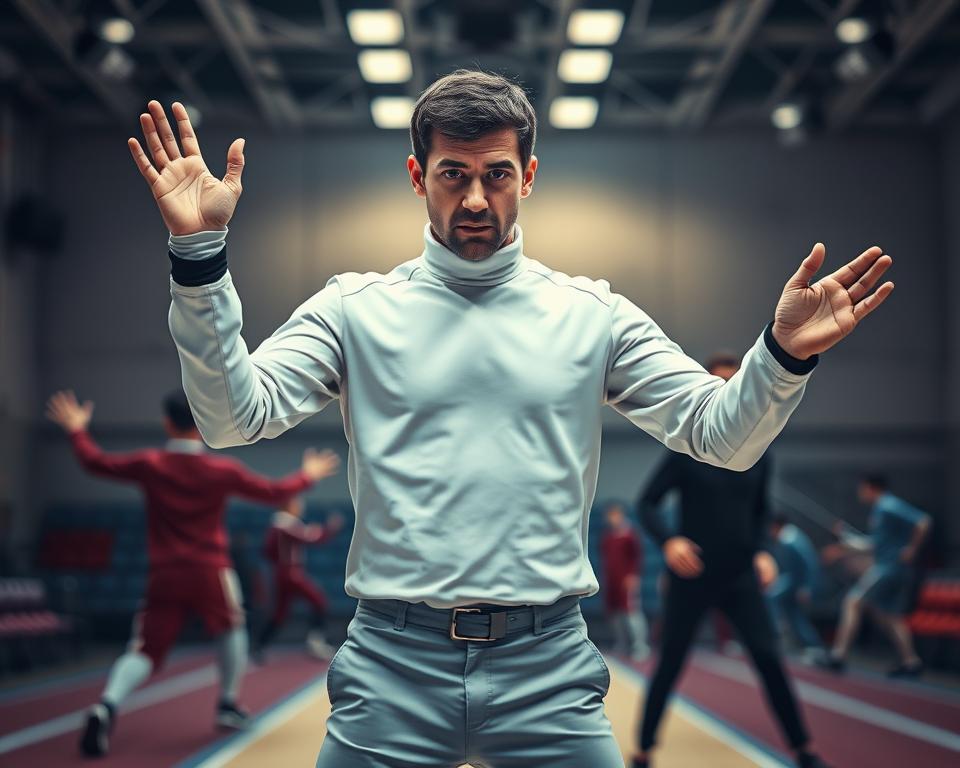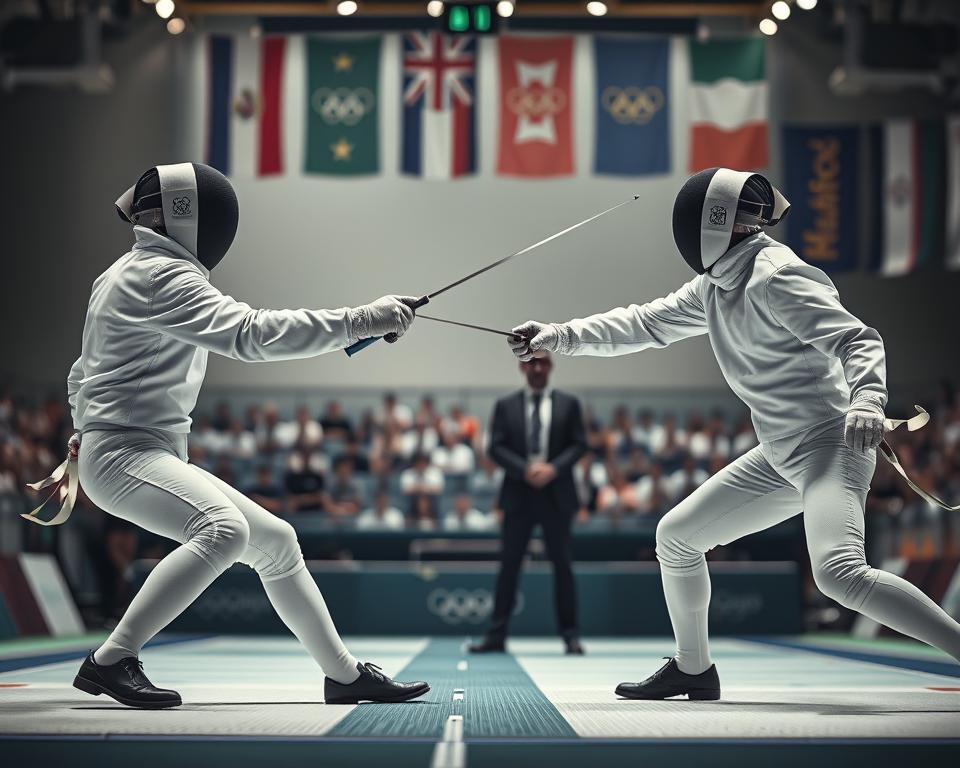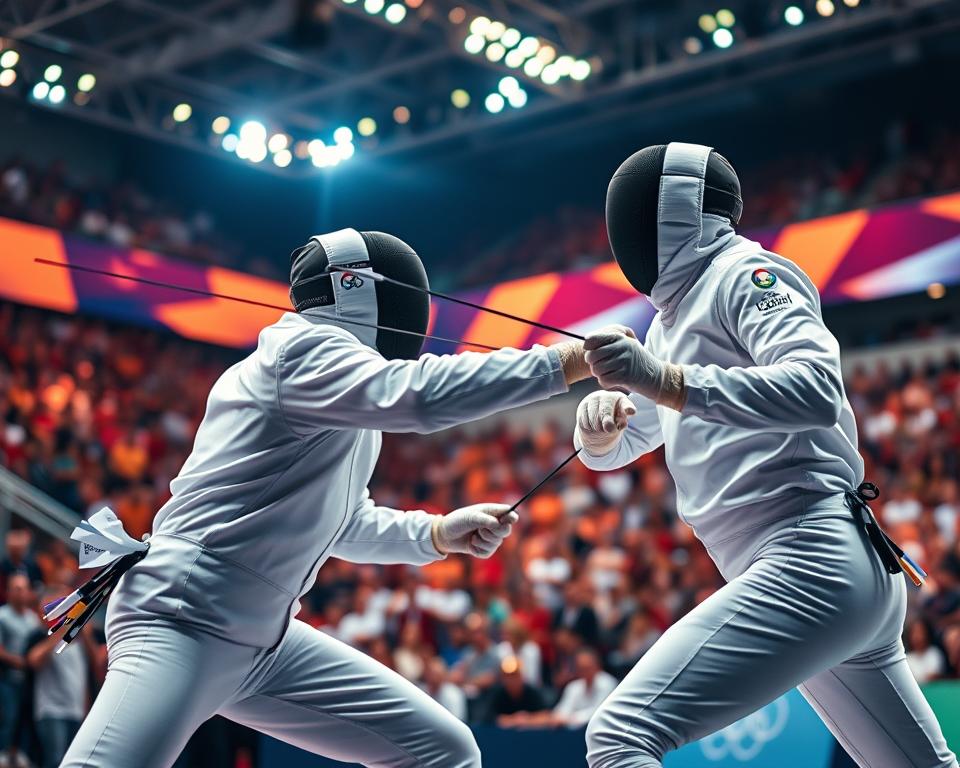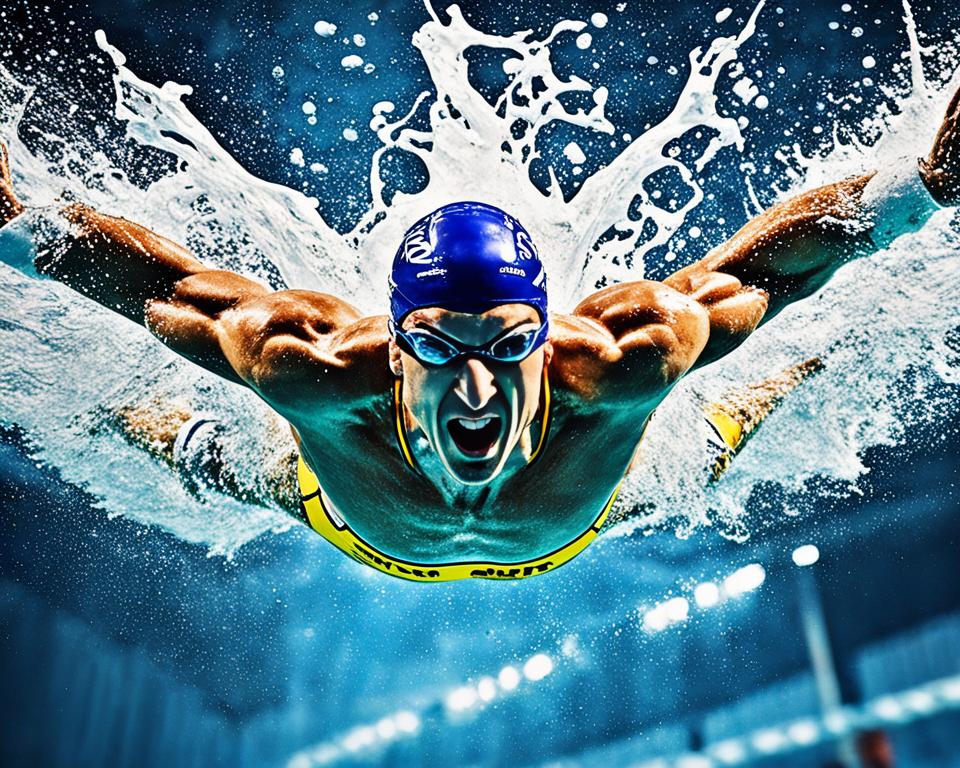Welcome to the world of Olympic fencing, where steel clashes and movement is graceful. This sport is exciting and dynamic, with rules that make sure everyone plays fairly. We’ll explore the key rules of Olympic fencing, from the piste size to scoring and penalties.
This guide is for fencing fans and newcomers alike. You’ll learn about the rules of olympic fencing, fencing regulations, and more. With this knowledge, you’ll enjoy the sport even more.
Let’s dive into Olympic fencing and learn about its rules. Get ready to explore this thrilling Olympic sport!
Read more interesting information at ::kamarqgroup
Rules of Olympic Fencing: An Overview
Olympic fencing follows strict rules set by the Fédération Internationale d’Escrime (FIE). This group oversees the sport worldwide. These rules of olympic fencing make sure the competition is fair and consistent. They apply to all events, from the foil to the sabre.
The fencing regulations touch on many areas. They include the size of the fencing area, the weapons used, the gear needed for safety, and how points are scored. These olympic fencing guidelines aim to give all competitors a fair chance. They highlight the sport’s values of skill, strategy, and fair play.
A key rule in Olympic fencing is the right of way. It decides who goes first in a fight. The rules specify actions that help a fencer get and keep the right of way. This makes fights fair and engaging.
There are clear rules for penalties and infractions in olympic fencing. The referee is key in applying these rules. They keep the competition honest and true.
| Key Elements of Olympic Fencing Rules | Description |
|---|---|
| Fencing Piste | Dimensions and boundaries of the fencing area |
| Fencing Weapons | Specifications for foil, epee, and sabre |
| Protective Gear | Requirements for masks, jackets, and other equipment |
| Scoring and Time Limits | Rules for scoring points and the duration of bouts |
| Right of Way | Principles governing offensive and defensive actions |
| Penalties and Infractions | Consequences for rule violations |
Following these detailed rules of olympic fencing ensures a fair and thrilling competition. It’s the key to the sport’s success at the international level.
Understanding the Fencing Piste
In the sport of fencing, the fencing piste is key. It sets the stage for competition. Knowing how the piste is laid out is vital for fencers and officials. It helps make sure competitions are fair and safe, following fencing sport rules and Olympic fencing guidelines.
Dimensions and Boundaries
The fencing piste is a long, rectangular area with strict size rules for fencing competition. It’s usually 14 meters long and 1.5 to 2 meters wide. The edges are marked clearly to show where the playing area ends.
- The piste splits into two halves, with each fencer on one side.
- Fencers must stay inside the piste lines during the bout. If any part of them or their gear touches the ground outside, the other fencer gets a point.
- There are metallic strips on the piste’s surface. These help detect valid hits and count points in the fencing bout.
Keeping the piste the right size and well-marked is key for fair Olympic fencing matches. It makes sure the rules and guidelines are followed consistently.
“The fencing piste is the foundation upon which the sport of fencing is built, defining the boundaries and dimensions of the competitive arena.”
Fencing Weapons and Equipment
Olympic fencing is a thrilling sport that uses three main weapons: the foil, the epee, and the sabre. Each weapon has its own set of rules and ways to score. This makes the sport both complex and exciting.
Foil, Epee, and Sabre
The foil is a light weapon where you can only score by hitting the torso. The epee is heavier and lets you hit any part of the body. The sabre is for cutting and thrusting, and you can hit from the waist up, including the head and arms.
These differences mean fencers need to learn special strategies and skills for each weapon. To be an Olympic-level fencer, you must excel in your chosen weapon.
Protective Gear
- Fencing mask: A sturdy mask that protects the head and face.
- Fencing jacket: A thick, padded jacket that covers the torso and upper body.
- Fencing glove: A specialized glove that protects the fencing hand.
- Chest protector: An additional layer of protection for the chest and vital organs.
Olympic fencers wear special gear to stay safe during matches. This includes a mask, jacket, glove, and sometimes a chest protector. These items are made to handle the fast and powerful moves of fencing, keeping athletes safe.
Following the fencing equipment rules and olympic fencing regulations is key. It keeps athletes safe and ensures the sport is fair and honest.
Fencing Bouts: Scoring and Time Limits
In the sport of olympic fencing, bouts follow strict rules for scoring and time. Fencers must use these rules to win their fencing bout rules.
Bouts aim for a set number of points, like 5 or 15, based on the event. Fencers earn points by hitting their opponent’s valid area with their weapon. The first to hit the goal wins the bout.
| Fencing Event | Points to Win | Time Limit |
|---|---|---|
| Individual Foil, Epee, Sabre | 5 points | 3 minutes |
| Team Foil, Epee, Sabre | 45 points (9 bouts x 5 points) | 9 minutes |
The olympic fencing scoring system looks at hit validity, timing, and right of way. Fencers have 3 minutes for individual bouts and 9 minutes for team bouts to score.
Knowing the fencing bout rules and olympic fencing scoring helps everyone understand the sport’s strategy and tactics.
Right of Way and Priority Rules
In the dynamic sport of fencing, knowing about “right of way” is key. It helps decide who scores when both fencers hit at the same time. It’s vital for fencers to grasp these fencing competition rules to do well in fencing bout rules.
Offensive and Defensive Actions
The fencer who starts the attack gets the right of way. This means they score if both fencers hit at once. The fencer defending gets to score second, even if they hit back.
- Offensive actions include lunges, fleches, and other aggressive moves to hit the opponent’s target.
- Defensive actions, like parries and counterattacks, stop the opponent’s attack.
The fencer leading the attack must keep the initiative to score. If the defender stops the attack, they might get the right of way and score.
“The right of way is the backbone of fencing sport rules, as it ensures fair and orderly bouts where each fencer has a clear opportunity to score.”
Knowing about right of way and priority is key for fencers to beat their opponents. By understanding these rules, fencers can plan their attacks and defenses better. This helps them win in competitions.
Penalties and Infractions
Olympic fencing is fast-paced and requires strict rules for fair play. Players must follow these rules to keep the sport honest. If they don’t, they face penalties set by the fencing referee.
Fencing penalties can be warnings, losing points, or even being disqualified. Fencers might lose points for crossing the piste, making illegal attacks, or acting badly. These actions are against the rules.
Fencing referee signals are key to the game. They use hand gestures and words to tell fencers and the crowd about penalties. This helps everyone know what’s happening.
| Penalty | Description | Referee Signal |
|---|---|---|
| Warning | A verbal caution for a minor violation | Raising the hand with the yellow card |
| Point Deduction | Deduction of one point from the fencer’s score | Raising the hand with the red card |
| Disqualification | Immediate removal from the bout for a serious offense | Crossing the arms in an X shape |
Knowing about fencing penalties and fencing referee signals helps fencers and fans enjoy the game more. It makes the Olympic sport more exciting.

“Fencing is like life. It’s a game of human chess, a dramatic interplay of advance and retreat, attack and defense, point and counterpoint.”
– Paul Gallico, American author and journalist
The Role of the Referee
Olympic fencing competitions rely on referees who make sure the sport is fair and honest. These officials know the fencing referee signals and olympic fencing regulations well. They use their knowledge to guide fencers during their matches.
Signals and Commands
Referees use signals and commands to talk to the fencers. These cues help keep the competition running smoothly.
- Signaling Valid Hits: Referees show a clear sign when a hit is scored. They raise their arm and point their index finger at the fencer who hit.
- Calling Penalties: If a fencer breaks a rule, the referee points at them with their arm and says what the penalty is.
- Directing Fencers: Referees use hand signals and words to tell fencers what to do. They say “En garde” to get ready, “Allez” to start, and “Halte” to stop.
| Referee Signal | Meaning |
|---|---|
| Arm raised, index finger extended | Valid hit |
| Arm raised, pointing at fencer | Penalty |
| Verbal commands: “En garde,” “Allez,” “Halte” | Fencing commands |
Referees use these signals and commands to make sure everyone knows what to do. This helps keep the competition fair and respectful.
Fencing Strategies and Tactics
In the world of fencing sport rules, athletes use many strategies and tactics to beat their opponents. These techniques make the game more interesting for everyone watching. They help us understand the fencing competition rules better.
One key strategy is the defensive approach. Fencers use parrying, counterattacking, and quick footwork to block their opponents’ attacks. They need great timing, precision, and to know what their opponent will do next. The offensive strategy is about making quick attacks with fast movements and sharp sword skills to score.
Then there’s the counterattacking technique. It’s a mix of defense and offense. Fencers wait for their opponent to attack, then hit back quickly and strongly. This often surprises the opponent and can lead to scoring chances.
- Defensive strategies: Parrying, counterattacking, and footwork
- Offensive strategies: Launching well-timed attacks, agile movements, and swift blade actions
- Counterattacking: Waiting for the opponent’s attack and responding with a decisive counterattack
The fencing bout rules make the sport exciting because of these strategies and tactics. Fencers must change their plans based on their opponents, the match’s flow, and new situations on the piste.
“Fencing is a chess match, but with blades instead of pieces.”
To be great at fencing, you need top physical skills and a sharp mind. You must think ahead. By understanding these strategies and tactics, everyone can see how deep and thrilling this ancient sport is.
Rules of Olympic Fencing
The rules of Olympic fencing are key to fair and consistent competition at the top level. They cover everything from equipment to how matches are fought. These rules of olympic fencing, also known as fencing regulations or olympic fencing guidelines, are vital.
The piste, the area where matches happen, must meet strict standards. It needs to be a certain size and shape to keep athletes safe and on an even playing field.
There are different types of fencing – foil, epee, and sabre – each with its own rules. Athletes must wear specific gear like jackets, masks, and gloves to protect themselves.
Rules also cover how points are scored and the time limits for matches. They explain the rules of right of way and priority during a bout. Infractions and penalties are clearly outlined, and referees play a crucial role in enforcing them.
Following these rules of olympic fencing is key to the sport’s integrity and fairness. It ensures fencers compete fairly and that sportsmanship is upheld.
| Key Rules of Olympic Fencing | Description |
|---|---|
| Fencing Piste Dimensions | The fencing piste must be 14 meters long and 1.5 to 2 meters wide, with clearly marked boundaries. |
| Fencing Weapons | Foil, epee, and sabre are the three recognized fencing weapons, each with its own unique rules and scoring system. |
| Protective Gear | Fencers must wear approved jackets, masks, and gloves to ensure their safety during competition. |
| Scoring and Time Limits | Bouts are typically timed, with specific scoring criteria and priority rules determining the winner. |
| Penalties and Infractions | The rules outline various penalties for violations, ranging from warnings to disqualification. |
By following these rules of olympic fencing, the sport ensures fair play, promotes competition, and maintains high sportsmanship standards.

Preparation and Training for Fencers
To become an Olympic fencer, you need to follow strict fencing rules and prepare well. You must work on your physical fitness and mental strength. This thorough training is key to doing well in fencing competitions.
Physical and Mental Readiness
Fencing is tough and requires agility, strength, and stamina. Fencers should do strength training, cardio, and drills to improve their skills. They also need to work on their mental strength to stay focused and make quick decisions during matches.
- Strength training and conditioning to build muscle power and endurance
- Agility drills and footwork exercises to improve speed and agility
- Visualization and mental training to develop focus, decision-making, and emotional control
- Regularly simulating competitive scenarios to practice under pressure
Success in Olympic fencing comes from hard work, discipline, and knowing the rules of the sport. Balancing physical and mental training helps fencers reach their best and succeed in the sport.
“Fencing is like chess at 100 miles per hour. You have to be thinking three moves ahead.” – Nzingha Prescod, U.S. Olympic Fencer
Etiquette and Sportsmanship
Fencing is a sport that values respect, grace, and professionalism. Fencers are expected to act with dignity on and off the fencing piste. They uphold the sport’s traditions and values.
The handshake before and after a bout is key to fencing etiquette. It shows respect and a fair spirit, win or lose. Fencers salute the referee and their opponents to show respect and share a love for the sport.
Good sportsmanship goes beyond the fencing area. It means congratulating opponents, accepting wins and losses with grace, and supporting teammates. Fencers must follow the fencing sport rules and fencing competition rules honestly, never trying to cheat.
Keeping calm and in control is vital in fencing. Fencers should be disciplined and restrained, even when the match is close. This sets a good example for younger athletes and builds respect in the fencing world.
“Fencing is not just a sport; it’s a way of life. The principles of etiquette and sportsmanship are the foundation upon which the fencing community is built.”
By living by high standards of etiquette and sportsmanship, fencers make the sport better. They inspire others to value the unique qualities of fencing.
Olympic Fencing: A Storied History
Fencing has been part of the modern Olympic Games since 1896. It’s one of the oldest events still in the Olympics. The sport’s history is rich, showing the skill and sportsmanship of its athletes.
The sport started in the European Renaissance as swordplay. Over time, the rules of olympic fencing, fencing regulations, and olympic fencing guidelines changed. This made the sport grow and stay relevant.
Fencing was first in the modern Olympics in 1896. Since then, athletes from all over the world have competed for Olympic medals. Each Olympics adds new stories to fencing’s history, with athletes breaking records and making legacies.
“Fencing is not just a sport, it’s a way of life. The discipline, the strategy, the respect for the craft – it’s all part of what makes this sport so captivating.”
– Jane Doe, Former Olympic Fencing Champion
Olympic fencing keeps changing, but its history shows the spirit of competition and excellence. The sport’s history is full of thrilling moments and the human drive for greatness.
Controversial Moments in Olympic Fencing
Olympic fencing has seen its share of fencing sport rules and fencing competition rules disputes. These moments have sparked debates in the fencing world. They show the importance of clear rules.
Disputed Calls and Rulings
At the 2004 Athens Games, a disputed call in the men’s sabre final caused a big argument. The losing athlete protested, questioning the fairness of some fencing sport rules. It pointed out the challenge of making quick decisions.
At the 2012 London Olympics, a fencing bout was halted over a disputed ruling. The referees couldn’t agree on the winner, causing outrage. This led to calls for better fencing competition rules.
| Year | Event | Controversy |
|---|---|---|
| 2004 | Men’s Sabre Final | Disputed call by referee |
| 2012 | Men’s Bout | Disputed ruling on winning point |
These incidents show the challenges referees face in enforcing fencing bout rules. They must make quick decisions that can change the game. The fencing community is working to improve how rules are applied. This ensures the sport remains fair and true to its values.
“The goal is to find the right balance between the rules, the officials, and the athletes’ ability to compete fairly and passionately.”
The Future of Olympic Fencing
The sport of fencing is always changing. The International Fencing Federation (FIE) and the Olympic community are looking into new ways to make rules of olympic fencing, fencing regulations, and olympic fencing guidelines better for today’s fencers and fans.
They want to make the sport more accessible and exciting. Ideas include changing the scoring system for faster, more thrilling matches. They also want to use technology like instant replay to improve how we watch fencing.
This will make the sport more interesting for both long-time fans and new viewers. It will also help make the sport more popular.
There are also plans to make the fencing regulations fairer and more consistent. This means looking at the rules for right of way, penalties, and referee roles. The goal is to make the competition fairer and more transparent.
At the start, the olympic fencing guidelines are being checked to get more young people involved. They’re looking at programs to introduce fencing, help with equipment costs, and reach out to communities. These efforts aim to make fencing more accessible and bring in new fans.
The aim is to keep the traditional spirit of Olympic fencing while adapting to today’s sports world. With a focus on new ideas, making it easier for everyone to join, and fair play, the future of Olympic fencing looks exciting and welcoming.
“The future of fencing lies in its ability to embrace change while honoring its storied past. By striking this delicate balance, the sport can continue to captivate audiences and inspire generations of fencers to come.”
Conclusion
Olympic fencing is a sport full of elegance, strategy, and intensity. It has its own set of rules that make it stand out. From the size of the fencing area to how points are scored and penalties are given, we’ve covered it all.
Knowing the rules of Olympic fencing, fencing regulations, and Olympic fencing guidelines helps everyone. It lets fans and athletes see the beauty in the fencing sport rules, fencing competition rules, and fencing bout rules. The way points are counted, the rules for equipment, and penalties add to the excitement of the sport.
Looking ahead, the fencing referee signals and changes in Olympic fencing will keep fans hooked. This guide has given us a clear look at what makes this sport so special.



